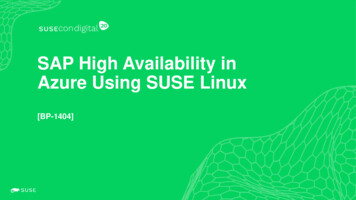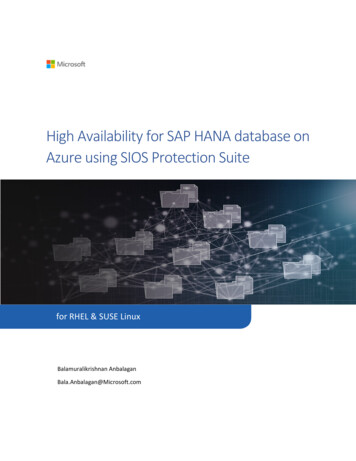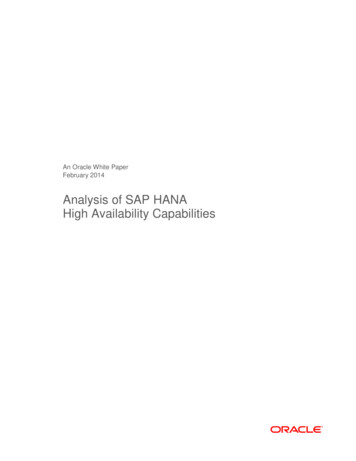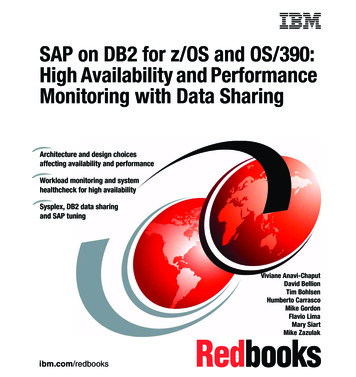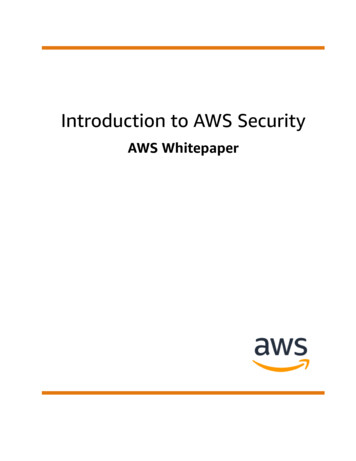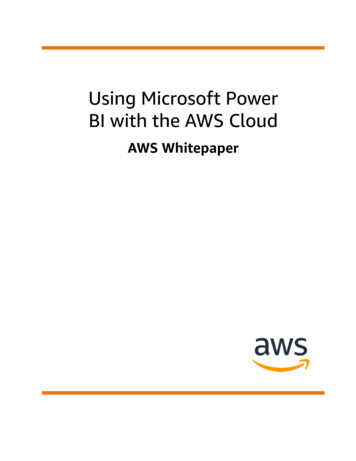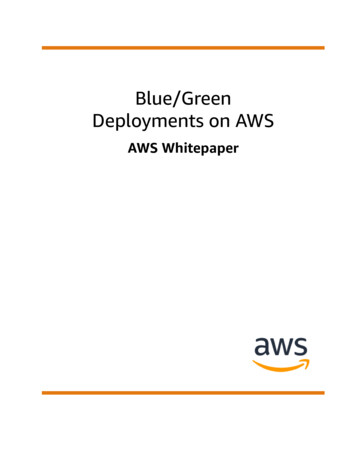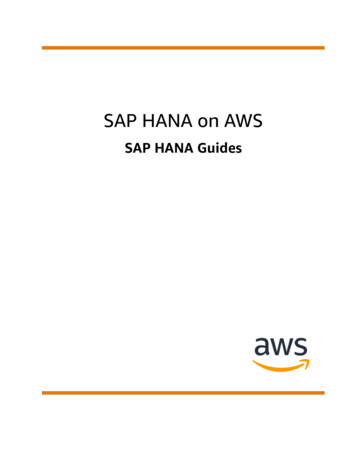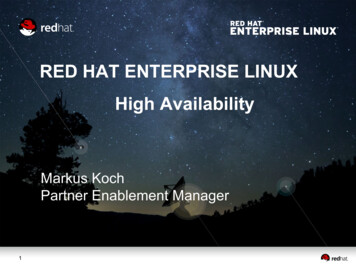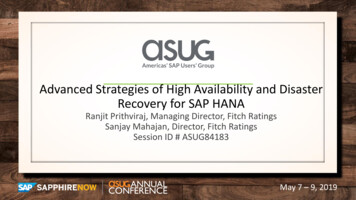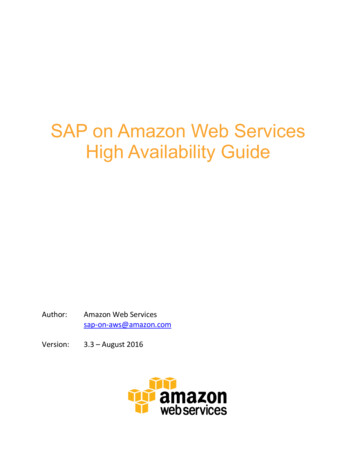
Transcription
SAP on Amazon Web ServicesHigh Availability GuideAuthor:Amazon Web Servicessap-on-aws@amazon.comVersion:3.3 – August 2016
Amazon Web Services – SAP on AWS High Availability GuideAugust 2016ContentsDOCUMENT HISTORY3ABOUT THIS GUIDE4WHAT IS NOT INCLUDED IN THIS GUIDE.4PREREQUISITE DOCUMENTATION5SAP ON AMAZON WEB SERVICESSAP ON LINUXSAP ON WINDOWS555OVERVIEW OF THE HIGH AVAILABILITY CONCEPT6HIGH AVAILABILITY FOR SAP ON AWSPLANNING THE DEPLOYMENTSECURITY GROUPS679INSTALLING THE SAP ENVIRONMENT10CREATING AN AMAZON VPCPREPARING AND INSTALLING THE FIRST (A)SCS INSTANCECONFIGURING THE SECOND SERVER FOR THE (A)SCS INSTANCE – LOCAL FAILOVER SCENARIOTESTING THE SAP (A)SCS INSTANCE FAILOVER – LOCAL FAILOVER SCENARIOCONFIGURING THE THIRD SERVER FOR THE (A)SCS INSTANCE – MULTI-AZ FAILOVER SCENARIOTESTING THE SAP (A)SCS INSTANCE FAILOVER – REMOTE FAILOVER SCENARIOINSTALLING THE PRIMARY DATABASECONFIGURING THE SECONDARY DATABASETESTING FAILOVER FOR THE DATABASEINSTALLING THE PRIMARY APPLICATION SERVER INSTANCE AND SUBSEQUENT DIALOG INSTANCESMAKING THE WEB TIER HIGHLY AVAILABLE AND EXTERNAL ACCESS1011151719202122232526SUMMARY27APPENDIX A – RESOURCES FOR DATABASE HA SOLUTIONS28APPENDIX B – AUTOMATING DEFAULT ROUTE AND POLICY CONFIGURATIONS29APPENDIX C – ADDITIONAL TIPS30Page 2 of 31
Amazon Web Services – SAP on AWS High Availability GuideAugust 2016 2016, Amazon Web Services, Inc. or its affiliates. All rights reserved.NoticesThis document is provided for informational purposes only. It represents AWS’s current productofferings and practices as of the date of issue of this document, which are subject to change withoutnotice. Customers are responsible for making their own independent assessment of the information inthis document and any use of AWS’s products or services, each of which is provided “as is” withoutwarranty of any kind, whether express or implied. This document does not create any warranties,representations, contractual commitments, conditions or assurances from AWS, its affiliates, suppliersor licensors. The responsibilities and liabilities of AWS to its customers are controlled by AWSagreements, and this document is not part of, nor does it modify, any agreement between AWS and itscustomers.Page 3 of 31
Amazon Web Services – SAP on AWS High Availability GuideAugust 2016Document HistoryImportantBefore installing the SAP solution on AWS, make sure to have the latest version of this document. Thelatest version can be found at http://aws.amazon.com/sap/ in the technical content /2016DescriptionDocument createdExtension into multiple AZs for increased availability & durability.SAP Web Dispatcher & external access informationMinor editsRemoved AWS component level documentationConsolidated SAP notesMinor edits, updatesUpdated Oracle support and HANA DB supportAbout This GuideThe intent of this guide is to provide an overview of how to configure SAP systems on Amazon ElasticCompute Cloud (Amazon EC2) in such a way as to be able to protect the application from various singlepoints of failure. This guide will explore how features native to the Amazon Web Services (AWS)platform in combination with SAP installation techniques can greatly improve the availability of an SAPdeployment. This guide is not meant to be an exhaustive list of all possible configuration options but ismeant to serve as a guide for solutions common to most deployment scenarios.What is not included in this guide.Please note that this guide is not intended to replace the standard SAP installation guides, as well asoperating system and/or RDBMS documentation. In addition, much of this guide builds on concepts andAmazon EC2 technology components discussed in both the SAP on AWS Operation and Implementationguides.Apart from some examples, this guide does not include detailed instructions on how to configuredatabases for high availability, for instance using SQL Server Mirroring or Oracle Data Guard. Pleaserefer to the specific documentation for RDBMS high availability features for setup and configuration.This guide is also not intended to cover all the business reasons and decision criteria for decidingwhether or not to implement a high-availability solution on AWS.Page 4 of 31
Amazon Web Services – SAP on AWS High Availability GuideAugust 2016Prerequisite DocumentationTo ensure SAP systems are installed on the AWS platform in manner consistent with SAP’s supportrequirements, it is recommended to first begin installation planning by referring to the standard SAPdocumentation and notes for each respective SAP solution being installed. http://service.sap.com/instguides http://service.sap.com/notesSAP on Amazon Web ServicesThis guide assumes that the reader is already familiar with implementing and operating SAP solutions onthe Amazon Web Services infrastructure. Please be sure to read the SAP on AWS Implementation Guideand the SAP on AWS Operations Guide before continuing. All AWS guides for SAP can be found athttp://aws.amazon.com/sap.Table 1 lists the available SAP notes for deploying SAP on AWS infrastructure.Table 1: SAP notes for deploying SAP on AWSNote #158866716560991656250DescriptionSAP on AWS: Overview of related SAP Notes and Web-LinksSAP on AWS: Supported SAP, DB/OS and AWS EC2 productsSAP on AWS: Support prerequisitesFeedback on this guide can be sent to sap-on-aws@amazon.com.Other general documentation that may be helpful:SAP on Linux SAP SCN Page on Linux SAP on Linux in general (FAQ) Red Hat Enterprise Linux Knowledge Repository SUSE Linux Enterprise Server 11 documentationSAP Note #171356DescriptionSAP Software on Linux: Essential informationSAP on Windows SAP SCN Page on Microsoft Windows SAP on Windows Server 2008 R2 (FAQ) SAP on Windows Server 2012 (FAQ)SAP Note #148677217321611564275Page 5 of 31DescriptionSAP Systems on Windows Server 2008 R2SAP Systems on Windows Server 2012 2012R2How to install an SAP System or SAP components on Windows using VirtualHost names
Amazon Web Services – SAP on AWS High Availability GuideAugust 2016Overview of the High Availability ConceptHigh availability or HA solutions are designed to protect the single points of failure (SPoF) of a softwaresystem. As previously stated, there are some key differences in the high-availability concept on the AWSplatform as compared to conventional software cluster-based solutions, the two primary differencesbeing shared-storage devices and the restriction of broadcast or multicast traffic within the AWSnetwork.Traditional clustering solutions typically use shared storage devices for quorum or “lock devices” as wellas shared application and/or database volumes. These volumes are usually presented to multiple hostswith read/write access being controlled by the cluster software. Conversely, an Amazon Elastic BlockStore (Amazon EBS) volume can only be attached to one instance at a given time. This is for both writeconsistency and redundancy for the Amazon EBS volume.In addition, many clustering solutions (Microsoft Clustering, for example) use layer 2 network functionsincluding multicast or broadcast packets to check for node failures within the cluster. This type oftraffic is not allowed in Amazon Virtual Private Cloud (Amazon VPC), which results in many clustersolutions not being able to function correctly. Furthermore, these solutions also rely on the ability toswap IP addresses from within the guest operating system, which is also not currently supported.Before discussing the specifics of the high-availability solution, it’s important to understand the classicsingle points of failure in an SAP system. These components of the system are critical for operation andinclude functions such load balancing, license management, and lock management. The SAP applicationdoes have built-in redundancy for many of the other key components through its ability to distributeand scale out dialog instances.SAP Environment SPoFMessage Server - (A)SCS instanceEnqueue Server - (A)SCS instanceSAP Web DispatcherDatabaseNative SAP High AvailabilityABAP Dialog and Batch work processesUpdate work processesGateway work processesSpool work processesJ2EE cluster nodesFurther information on SAP high availability scenarios can be found on the SCN High Availability webpage.High Availability for SAP on AWSThe concepts discussed in this guide will attempt both to provide a high-availability solution that closelyresembles a typical on-premise installation, and to show how features delivered by the AWS platform incombination with SAP installation options allow for a high-availability solution that extends beyond asingle datacenter.The high-availability solution as discussed in this guide will include the following key components:Page 6 of 31
Amazon Web Services – SAP on AWS High Availability Guide August 2016Installing or copying the SAP system into an Amazon VPC, while leveraging multiple subnets andAvailability Zones.Distributing the various SAP application and database components onto multiple instances.Using the SAP installer option SAPINST USE HOSTNAME for virtual hostnames, which are thenmapped to static IP addresses via DNS.Using a secondary AWS Elastic Network Interface (ENI) to relocate the aforementioned IPaddress associated with the virtual hostname from one AWS instance to another.Using AWS security groups in combination with the re-locatable ENI to properly place a virtualnetwork “fence” around the SAP central services and database instances so as to avoidmiscommunication and to isolate failed resources.Using database stand-by and/or mirroring techniques to protect the database layer.Leveraging the ability to re-map Amazon EBS volumes from one instance to another to relocateglobal SAP file systems for failover of the SAP central services instance within a single AvailabilityZone.Protection of the SAP central services instance in the event of a complete Availability Zonefailure.Use of Amazon Machine Images (AMIs) to quickly provision additional SAP instances for capacityor to cover failures.Planning the DeploymentPlanning the deployment beforehand is a key step to ensuring success in an SAP high-availabilitydeployment on AWS. There are a number of items that should be considered up front. The AmazonVPC IP Address range/CIDR block and subnet ranges are completely user configurable. Throughout theexamples in this guide the solution will leverage two separate Availability Zones and spread the SAPApplication, database, and administrative services across both to maximize availability and durability. Inmost cases, two Elastic Network Interfaces (ENIs) will be attached to each instance, the first beingassociated with a “management” subnet, and the second with an “application” subnet. The followingtable should help in planning an SAP deployment into an Amazon VPC for this particular solution.ItemRegionAvailability Zone 1Availability Zone 2VPC IP Range/CIDR BlockManagement Network IPSubnet Range/CIDR block Availability Zone #1Application Network IP SubnetRange/CIDR block Availability Zone #1Page 7 of 31Key ConsiderationsExampleLatency requirements, distance from us-west-2end usersus-west-2aus-west-2bEnsure range does not overlap with192.168.0.0/16existing internal IP range. Size IPrange appropriate for number ofhosts and planned growthSize subnet should accommodate192.168.1.0/24for growthSize subnet should accommodatefor growth192.168.2.0/24
Amazon Web Services – SAP on AWS High Availability GuideApplication Network IP SubnetRange/CIDR block Availability Zone #2Management Network IPSubnet Range/CIDR block Availability Zone #2Setup VPN TunnelActive Directory (AD)DNSBastion and/or RemoteDesktop GatewayAugust 2016Size subnet should accommodatefor growth192.168.3.0/24Size subnet should accommodatefor growth192.168.4.0/24On premise router configuration,choice of VPN tunnel over Internetto Amazon VPC, or Amazon DirectConnect to VPN GatewayConsider using on-premise AD asprimary with secondary in eachAmazon VPC Availability Zone.Use on-premise DNS Server asprimary with secondary in each AWSVPC Availability Zone.For remote administration over anInternet connectionTo help isolate single points of failure, the distribution of the various SAP application and databasecomponents will be onto multiple AWS instances. The following high-level architecture diagram showsall application and network components. Each layer will be explored in detail throughout the remainderof this guide.Page 8 of 31
Amazon Web Services – SAP on AWS High Availability GuideAugust 2016Figure 1 – SAP distributed landscape deploymentSecurity GroupsIt’s helpful at this point to define the security groups that are used for controlling access to instances foradministrative functions, application and DB level communication, and isolating failed resources.NoteSecurity groups are firewall rules that the user defines at the instance or network interfacelevel to open or close specific ports for network communication. As the user, you will need tocome up with your own set of rules and configure these based on your application connectivity,setup, and integration requirements. A fairly comprehensive list of TCP/IP ports used by SAPApplications has been made available by SAP.It is strongly recommended that the SAP deployment team work closely with the networking team tounderstand what network traffic to allow in each tier and make configurations accordingly. Thefollowing ideas should help provide some structure and guidance: Set up a virtual private gateway and one customer gateway. These provide VPN connectivitybetween the corporate data center and the Amazon VPC.Set up route table configurations for all the traffic to and from the corporate data center overthe VPN tunnel.Define all communication on required protocols and ports using network ACLs.Page 9 of 31
Amazon Web Services – SAP on AWS High Availability Guide August 2016Set up security groups on management servers with restricted access from certain on-premisenetworks or IP addresses.Set up security groups with limited inbound and outbound protocols and ports for each instanceto be used at launch time.Configure additional security groups based on the specific SAP application and databasecommunication requirements and assign these to secondary interfaces.NoteServers within a particular Amazon VPC subnet may need to access resources on the Internet forthings such as software updates. Such actions can be accomplished by adding an Internet gatewayto the VPC and using a network address translation (NAT) instance placed within a public subnetto protect internal resources. The other method is to create network routes to direct the traffic totraverse the VPN tunnel, into the corporate data center, and out through corporate proxy servers.Installing the SAP EnvironmentCreating an Amazon VPCCreate an Amazon VPC in one of the available regions and specify a contiguous IP address range in CIDRblock format (e.g., 192.168.0.0/16). It’s important to choose a range that doesn’t overlap with analready existing range being used internally on the corporate network. Next, create four new subnets,associating each with the new Amazon VPC, and split them across two different Availability Zones. Tocontinue with the installation process, access to the instances deployed into the Amazon VPC will benecessary. This can be done either by using the VPN tunnel between the on-premise data center andthe Amazon VPC, or by leveraging an Internet gateway combined with Elastic IP addresses (EIPs). Inboth cases, be sure to create appropriate route tables, associate them with the new subnets, and adjustthe network ACLs with rules to meet internal security requirements.NoteAdditional subnets combined with network ACLs can further isolate or restrict access to different tiers ofthe SAP environment and also create multiple public and private subnets for isolation. Also note thatany subnet that is associated with an Internet gateway will become a public subnet.Once the Amazon VPC has been created, the next step is to deploy supporting infrastructure instancesthat will provide key services leveraged by the SAP environment from within the Amazon VPC. Some ofthese services might include: Active Directory servicesDNSNetwork address translation (NAT) servicesRemote Desktop gatewaysBastion hostsOtherPage 10 of 31
Amazon Web Services – SAP on AWS High Availability GuideAugust 2016It’s important to deploy these services in a highly available manner across Availability Zones. Whensupporting infrastructure services are in place, continue with the SAP deployments into the AmazonVPC.Figure 2 – Amazon VPC configured and ready for deploymentsPreparing and Installing the First (A)SCS Instance1. Launch a new Amazon EC2 Linux or Windows instance into Availability Zone 1 and specify IPaddresses for both the primary (management) and secondary (application) level interfaces.2. Next, choose to allocate Amazon EBS volumes, which will be used for both SAP local as well asglobal file systems. Volume sizes and the number will vary depending on installation needs. Linux specificsAn example drive configuration for a Linux-based SAP central services instance might look likethe following. A separate Amazon EBS volume is used for the local file systems as well asindividual volumes for each global file system that will be moved to the secondary SAP centralservices host.Page 11 of 31
Amazon Web Services – SAP on AWS High Availability diFile system usedlocallocal – (hostagent& ERS instance)relocatablerelocatablerelocatableAugust 2016Mount point(s)/LVM (/usr/sap & /usr/sap/ SID /ERS ## )/export/usr/sap/trans/export/sapmnt/ SID /usr/sap/ SID /ASCS ## TipIt is recommended to enter a 0 value for the sixth field entry (fs passno) in /etc/fstab for any ofthe devices that could be relocated to another instance. If the value is non-zero, the operatingsystem will attempt to fsck the file system upon start and will hang waiting for input from theconsole if the disk device is missing. Maintaining a value of 0 tells the fsck process to skip thefile system. IMPORTANT: If an Amazon EBS volume has been force detached from an instanceduring a failure scenario, the file system should be manually checked once the drive has beenattached to the failover (A)SCS host.Figure 3 - Example /etc/fstab entries Windows specificsAn example drive configuration for a Windows based SAP central services instance might looklike the following. In this example, only two Amazon EBS volumes have been used. One is forthe local directories leveraged by the host agent, ERS instance, etc. The other Amazon EBSvolume is used for the global sapmnt share.Device/dev/sda1/dev/sdf/dev/sdgFile system usedlocallocal – (hostagent & ERS instance)relocatableWindows driveC:D:E:3. Next, specify an already existing security group or create a new security group for this instance.Consider associating a more restrictive administrative security group to the instance duringlaunch time and assign a different security group customized for the SAP application to the ENIassociated with eth1 shortly after launch.Page 12 of 31
Amazon Web Services – SAP on AWS High Availability GuideAugust 20164. Once the instance has been launched, continue host preparation steps as outlined in both theSAP NetWeaver Installation guides as well as the SAP on AWS Implementation guide to preparethe instance for installing an SAP system. Additional Linux system configurationa) Be sure to check and update the static IP addresses and DNS info for both interfaces.b) Update the information for DNS, and ensure hostname to IP address resolution isworking properly.c) Because the secondary network interface (eth1) is on a different subnet, additionalconfiguration may be needed to route the packets coming in the eth1 interface back outthe same i
include functions such load balancing, license management, and lock management. The SAP application does have built-in redundancy for many of the other key components through its ability to distribute and scale out dialog instances. SAP Environment SPoF Message Server - (A)SCS instance Enqueue Server - (A)SCS instance SAP Web Dispatcher Database
